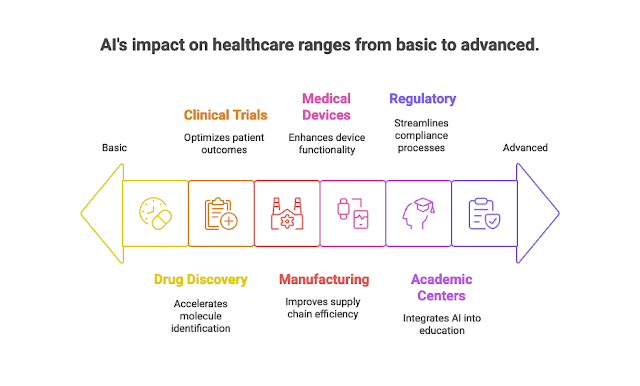Review: State of AI in Healthcare and Life Sciences—2025 Trends
Executive Summary
Artificial intelligence (AI) continues to reshape healthcare and life sciences in 2025, driving transformative changes across drug discovery, diagnostics, clinical workflows, and patient care. This report provides a comprehensive overview of the latest AI trends, market projections, challenges, and future outlook. It highlights how multimodal and generative AI are accelerating innovation and enabling personalized, efficient, and data-driven healthcare ecosystems.1. Introduction
The integration of AI into healthcare and life sciences has reached a pivotal point in 2025. From early-stage drug discovery to real-time patient monitoring, AI technologies are delivering unprecedented capabilities. This report synthesizes current trends, market data, and expert insights to provide a holistic understanding of AI’s evolving role in the sector.2. Key AI Trends in Healthcare and Life Sciences
2.1 Multimodal and Generative AI
- Multimodal AI combines heterogeneous data sources—including clinical notes, medical images, genomics, and wearable sensor data—to generate comprehensive insights. This fusion enables more accurate disease diagnosis, risk stratification, and personalized treatment planning.
- Generative AI models, such as large language models and generative adversarial networks (GANs), are revolutionizing healthcare by automating clinical documentation, generating synthetic datasets for research, and enhancing patient engagement through conversational agents. In drug discovery, generative AI accelerates molecule design and optimizes clinical trial protocols.
2.2 AI-Driven Drug Discovery and Development
- AI platforms have drastically shortened drug discovery timelines, enabling some molecules to progress from design to clinical trials within 12–18 months, compared to years under traditional methods.
- The AI-driven drug discovery market is projected to reach $13 billion by 2032, reflecting rapid adoption by pharmaceutical and biotech companies.
- AI optimizes clinical trials by improving patient recruitment accuracy, enabling adaptive trial designs, and facilitating real-time data analysis, which collectively reduce costs and improve trial success rates.
2.3 Personalized and Precision Medicine
- AI’s ability to analyze complex genetic, clinical, and lifestyle data facilitates precision medicine—tailoring therapies to individual patient profiles to maximize efficacy and minimize adverse effects.
- Machine learning algorithms are instrumental in identifying novel biomarkers, supporting the development of targeted therapies for cancer, rare diseases, and chronic conditions.
2.4 Clinical Operations and Workflow Automation
- AI automates numerous administrative and clinical tasks, including clinical coding, referral letter generation, and documentation, significantly reducing clinician workload and burnout.
- Ambient listening technologies and AI-powered chart summarization tools are becoming mainstream, enabling clinicians to spend more time on patient care rather than paperwork.
2.5 AI in Diagnostics and Imaging
- AI enhances diagnostic accuracy and speed by analyzing medical images (radiology, pathology) and detecting subtle anomalies that may be missed by human experts.
- Computational pathology powered by AI is improving diagnostic precision, prognostic assessments, and biomarker quantification, leading to better-informed clinical decisions.
2.6 Ecosystem Integration and Data Interoperability
- AI facilitates seamless integration across diverse health data sources—wearables, electronic health records (EHRs), and smart medical devices—forming connected ecosystems for holistic health management.
- Federated learning and privacy-preserving AI techniques address data security and regulatory compliance challenges, enabling collaborative research while safeguarding patient privacy.
3. Market Growth and Adoption
- AI in Pharma/Biotech: Expected to generate $350–$410 billion in annual value by 2025, driven by AI-enabled R&D, manufacturing, and supply chain optimization.
- AI in Drug Discovery: Market size anticipated to reach $13 billion by 2032, fueled by accelerated molecule design and clinical trial innovation.
- Generative AI in Healthcare: Experiencing rapid expansion, particularly in automating clinical workflows, documentation, and patient communication.
- AI Spending in Pharma: Estimated at $3 billion in 2025, reflecting increased investment in AI platforms and solutions.
- Regional Leadership: North America leads AI adoption due to advanced digital infrastructure, regulatory support, and investment climate.
4. Challenges and Considerations
4.1 Ethical and Regulatory Concerns
- Algorithmic bias and fairness remain critical issues, necessitating transparent AI models and diverse training datasets.
- Ensuring patient data privacy and meeting regulatory requirements (e.g., HIPAA, GDPR) require robust security frameworks and governance.
4.2 Data Quality and Integration
- AI’s effectiveness depends on high-quality, standardized, and interoperable data—a significant challenge given fragmented healthcare systems.
- Efforts to harmonize data formats and adopt common standards are ongoing but require industry-wide collaboration.
4.3 Workforce Readiness
- There is an urgent need for healthcare professionals skilled in AI literacy, data science, and digital health to implement and manage AI tools effectively.
- Training programs and interdisciplinary collaboration are essential to bridge this gap.
5. Future Outlook
AI’s trajectory in healthcare and life sciences points toward increasingly intelligent, autonomous, and integrated systems. Emerging areas include:
- Real-time AI-driven clinical decision support that adapts dynamically to patient status.
- Expanded use of AI in population health management and predictive analytics for preventive care.
- Greater patient empowerment through AI-enabled personalized health insights and virtual care.
Continued investment in research, ethical frameworks, and workforce development will be critical to fully realize AI’s transformative potential.
6. Conclusion
In 2025, AI is no longer a futuristic concept but a practical, essential component of healthcare and life sciences innovation. From accelerating drug discovery to enhancing diagnostics and streamlining clinical workflows, AI is delivering measurable value. While challenges persist, the sector is poised for sustained growth and impact, heralding a new era of precision, efficiency, and patient-centered care.
7. Recommendations
- Healthcare organizations should prioritize data quality initiatives and invest in interoperable systems.
- Pharma and biotech companies must integrate AI early in R&D pipelines to maximize competitive advantage.
- Policymakers and regulators need to develop clear guidelines that balance innovation with patient safety and privacy.
- Educational institutions should expand AI and digital health curricula to prepare the future workforce.
Related: Top 10 Artificial Intelligence Stocks 2025
.png)



.png)

.png)



.png)
Comments